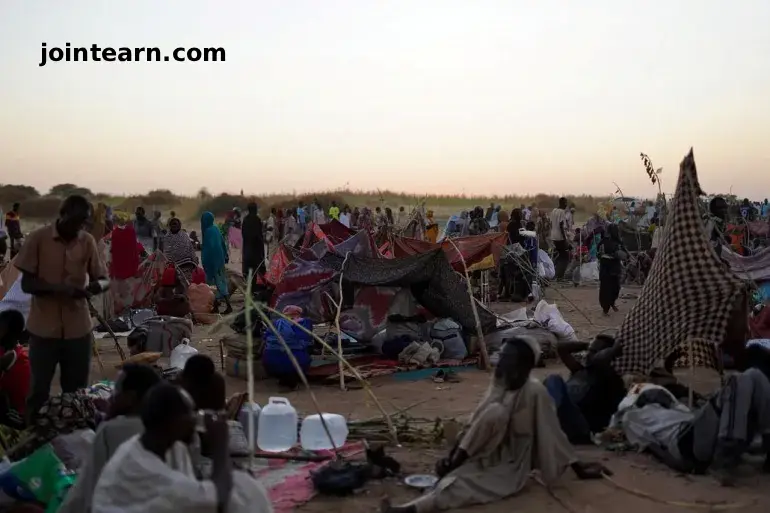
EL-FASHER, SUDAN — Survivors escaping from the war-ravaged city of el-Fasher in Sudan’s North Darfur region have described scenes of unimaginable horror following days of intense violence by the Rapid Support Forces (RSF). Witnesses report mass killings, looting, and indiscriminate attacks as thousands flee through perilous routes, leaving behind a city littered with bodies.
Humanitarian organisations now warn that only a fraction of el-Fasher’s population has managed to escape, while those who remain face starvation, disease, and continuing violence.
Mass Killings and Atrocities in El-Fasher
According to the Sudan Doctors Network, more than 1,500 civilians have been killed since the RSF captured el-Fasher on Sunday. The figure includes at least 460 people massacred inside Saudi Hospital, where patients, medical staff, and civilians had sought refuge.
The group described the RSF’s actions as “a systematic campaign of extermination.” Entire neighborhoods have been reduced to rubble, and families report losing loved ones in house-to-house searches.
Hayat, a mother of five who fled to Tawila, told AFP that armed RSF men stormed her home, assaulted her, and executed her teenage son in front of her.
“They searched my clothes, then shot my 16-year-old boy,” she said through tears. “When we escaped, the streets were full of corpses. Some wounded people were crying for help, but their families couldn’t carry them.”
Another survivor, Hussein, reached Tawila after being injured by shellfire.
“The city is a graveyard,” he said. “Dead bodies are everywhere, and no one is left to bury them.”
Aisha Ismael, who also fled, said residents faced relentless attacks from the air and ground.
“They hit us day and night,” she said. “We left barefoot after they looted everything we owned.”
Thousands Flee on Foot Toward Tawila
The United Nations estimates that more than 36,000 people have fled el-Fasher since Saturday, many walking up to 70 kilometers (43 miles) to reach the overcrowded town of Tawila, which already shelters 650,000 displaced Sudanese.
Al Jazeera’s Hiba Morgan, reporting from Khartoum, said that 15,000 people have arrived in Tawila in just the last 48 hours, many suffering from exhaustion, dehydration, and untreated injuries.
“Many walked for days without food or water,” Morgan reported. “They’re arriving traumatized and in desperate need of medical assistance.”
Aid agencies warn that Tawila — already at breaking point — is unable to handle the new influx. Mathilde Vu, advocacy manager for the Norwegian Refugee Council, said the number of arrivals is far lower than expected.
“Where are the others?” Vu asked. “That question alone tells the horror of the journey.”
UN: ‘El-Fasher Has Descended Into an Even Darker Hell’
The United Nations humanitarian chief, Tom Fletcher, told the UN Security Council on Thursday that the crisis in el-Fasher represents “catastrophic levels of human suffering.”
“The horror is continuing with utter impunity,” Fletcher said. “We are receiving credible reports of mass executions, rape, and abductions during the flight from the city.”
He warned that those fleeing toward Tawila face extortion, sexual violence, and roadside killings. Elderly people and the wounded remain stranded, unable to flee due to lack of transport and security.
To address the crisis, the UN has approved a $20 million emergency fund for Sudan to scale up humanitarian operations in Darfur. However, aid deliveries remain largely blocked by the RSF, preventing food and medical supplies from reaching survivors.
Bodies Visible from Space: Satellite Evidence of Mass Killings
International experts say the atrocities are visible even from orbit. The Yale Humanitarian Research Lab (HRL) has released satellite imagery showing “clusters of objects consistent with human bodies” and large areas stained with “red discoloration,” likely from spilled blood.
Shayna Lewis, a Sudan analyst, said the scale of violence was “most devastating because civil society groups had been warning of this for over a year.”
“For 18 months, the people of el-Fasher were trapped under siege,” she said. “Now, what the world ignored is visible from space.”
A City Under Siege for 18 Months
Before Sudan’s national army withdrew earlier this month, el-Fasher had endured 18 months of siege by the RSF. Food, fuel, and medicine were systematically cut off, trapping hundreds of thousands in near-famine conditions.
Civilians who attempted to flee were targeted by both air strikes and ground assaults. The Sudan Doctors Network says that many hospitals, including Saudi Hospital, were turned into “execution sites.”
Even after seizing the city, RSF forces reportedly looted aid warehouses and burned clinics. Satellite images confirm widespread destruction in residential neighborhoods and marketplaces.
Humanitarian Catastrophe in Darfur
The Darfur region, already one of the world’s most fragile humanitarian zones, now faces the threat of total collapse. UN agencies warn that disease outbreaks and famine could follow if aid access is not restored.
In Tawila, families sleep in the open without tents or sanitation. Children are suffering from malnutrition and waterborne diseases, according to the World Health Organization (WHO).
“Tawila is at a breaking point,” Fletcher said. “We need immediate access to provide food, water, and protection for those who have fled unimaginable violence.”
Calls for International Action
Human rights organizations are urging the UN Security Council, the African Union, and regional partners to act swiftly to protect civilians and hold RSF commanders accountable for war crimes.
Lewis warned that “impunity for the RSF” could lead to a repeat of the Darfur genocide of the early 2000s.
“The massacre in el-Fasher is a stark reminder that when the world turns away, atrocities return,” she said.
Leave a Reply